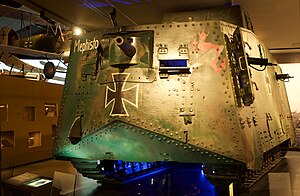
Back إيه7في Arabic A7V Azerbaijani A7V Sturmpanzerwagen Bulgarian A7V Breton A7V BS A7V Catalan A7V Czech A7V German A7V Sturmpanzerwagen Greek Sturmpanzerwagen A7V Spanish
| Sturmpanzerwagen A7V | |
|---|---|
 Sole surviving A7V (Mephisto) was on display at the Australian War Memorial in Canberra. Now on Permanant display at Queensland Museum, Brisbane, Queensland. | |
| Type | Heavy tank |
| Place of origin | German Empire |
| Service history | |
| In service | 21 March 1918 – 16 October 1918 |
| Used by | German Empire |
| Wars | World War I German Revolution |
| Production history | |
| Designer | Joseph Vollmer |
| Designed | 1916 |
| Manufacturer | Daimler Motoren Gesellschaft |
| No. built | 20 |
| Specifications | |
| Mass | 31.5 t (31.0 long tons; 34.7 short tons) battle weight |
| Length | 7.34 m (24 ft 1 in) |
| Width | 3.1 m (10 ft 2 in) |
| Height | 3.3 m (10 ft 10 in) |
| Crew | A minimum of 18, sometimes up to 25. |
| Armor | 5 to 30 mm (0.20 to 1.18 in)[1] |
Main armament | 5.7 cm Maxim-Nordenfelt (initially with 180 rounds; later 300) |
Secondary armament | 6 × 7.9 mm machine guns 36,000 rounds |
| Engine | 2 × Daimler-Benz 4-cylinder 200 hp (149 kW) total |
| Power/weight | 6.5 hp/tonne |
| Transmission | Adler gearboxes and differentials |
| Suspension | Holt track, vertical springs |
Operational range | 30–80 km (19–50 mi) |
| Maximum speed | 15 km/h (9.3 mph) on roads 6.4 km/h (4.0 mph) cross-country |
The Sturmpanzerwagen A7V was a heavy tank introduced by Germany in 1918 during World War I. One hundred chassis were ordered in early 1917, ten to be finished as fighting vehicles with armoured bodies, and the remainder as Überlandwagen cargo carriers.[2] The number to be armoured was later increased to 20. They were used in action from March to October 1918, and were the only tanks produced by Germany in World War I to be used in combat, as well as being the first operational German Tank.[3] It was developed as a response to British tanks. While certain publications have attempted to claim the A7V was an improvement over its British competition, there is nothing to support this suggestion. It was less capable across rough terrain, slower, required a far larger crew to operate and ultimately never had any success comparable to that of the British ‘Land Ships’.
- ^ Hull front: 30 mm (1.2 in), hull rear & sides: 15 mm (0.59 in), hull top:6 mm (0.24 in) Funk (2003), p. 135, command cupola: 20 mm (0.79 in) front, 15 mm (0.59 in) rear & sides and 5 mm (0.20 in) on top Funk (2003), p. 135
- ^ Zaloga (2006), pp. 7–10.
- ^ Tucker (2004), pp. 24–25.